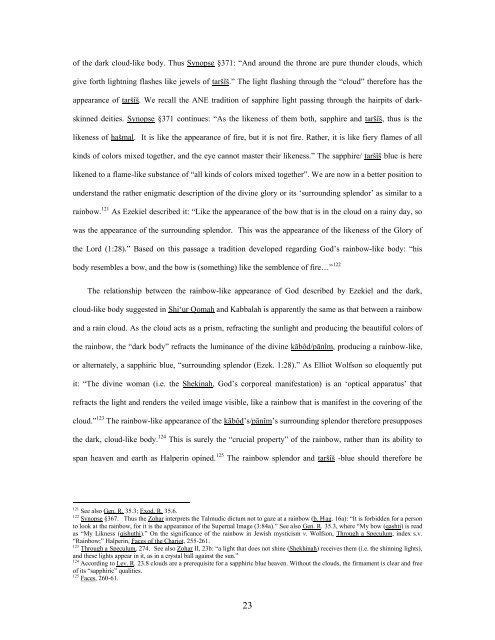Sapphiric God: - Dr. Wesley Muhammad
Sapphiric God: - Dr. Wesley Muhammad
Sapphiric God: - Dr. Wesley Muhammad
You also want an ePaper? Increase the reach of your titles
YUMPU automatically turns print PDFs into web optimized ePapers that Google loves.
of the dark cloud-like body. Thus Synopse §371: “And around the throne are pure thunder clouds, which<br />
give forth lightning flashes like jewels of taršîš.” The light flashing through the “cloud” therefore has the<br />
appearance of taršîš. We recall the ANE tradition of sapphire light passing through the hairpits of dark-<br />
skinned deities. Synopse §371 continues: “As the likeness of them both, sapphire and taršîš, thus is the<br />
likeness of hašmal. It is like the appearance of fire, but it is not fire. Rather, it is like fiery flames of all<br />
kinds of colors mixed together, and the eye cannot master their likeness.” The sapphire/ taršîš blue is here<br />
likened to a flame-like substance of “all kinds of colors mixed together”. We are now in a better position to<br />
understand the rather enigmatic description of the divine glory or its ‘surrounding splendor’ as similar to a<br />
rainbow. 121 As Ezekiel described it: “Like the appearance of the bow that is in the cloud on a rainy day, so<br />
was the appearance of the surrounding splendor. This was the appearance of the likeness of the Glory of<br />
the Lord (1:28).” Based on this passage a tradition developed regarding <strong>God</strong>’s rainbow-like body: “his<br />
body resembles a bow, and the bow is (something) like the semblence of fire…” 122<br />
The relationship between the rainbow-like appearance of <strong>God</strong> described by Ezekiel and the dark,<br />
cloud-like body suggested in Shi‘ur Qomah and Kabbalah is apparently the same as that between a rainbow<br />
and a rain cloud. As the cloud acts as a prism, refracting the sunlight and producing the beautiful colors of<br />
the rainbow, the “dark body” refracts the luminance of the divine kābôd/pānîm, producing a rainbow-like,<br />
or alternately, a sapphiric blue, “surrounding splendor (Ezek. 1:28).” As Elliot Wolfson so eloquently put<br />
it: “The divine woman (i.e. the Shekinah, <strong>God</strong>’s corporeal manifestation) is an ‘optical apparatus’ that<br />
refracts the light and renders the veiled image visible, like a rainbow that is manifest in the covering of the<br />
cloud.” 123 The rainbow-like appearance of the kābôd’s/pānîm’s surrounding splendor therefore presupposes<br />
the dark, cloud-like body. 124 This is surely the “crucial property” of the rainbow, rather than its ability to<br />
span heaven and earth as Halperin opined. 125 The rainbow splendor and taršîš -blue should therefore be<br />
121 See also Gen. R. 35.3; Exod. R. 35.6.<br />
122 Synopse §367. Thus the Zohar interprets the Talmudic dictum not to gaze at a rainbow (b. Hag. 16a): “It is forbidden for a person<br />
to look at the rainbow, for it is the appearance of the Supernal Image (3:84a).” See also Gen. R. 35.3, where “My bow (qashti) is read<br />
as “My Likness (qishuthi).” On the significance of the rainbow in Jewish mysticism v. Wolfson, Through a Speculum, index s.v.<br />
“Rainbow;” Halperin, Faces of the Chariot, 255-261.<br />
123 Through a Speculum, 274. See also Zohar II, 23b: “a light that does not shine (Shekhinah) receives them (i.e. the shinning lights),<br />
and these lights appear in it, as in a crystal ball against the sun.”<br />
124 According to Lev. R. 23.8 clouds are a prerequisite for a sapphiric blue heaven. Without the clouds, the firmament is clear and free<br />
of its “sapphiric” qualities.<br />
125 Faces, 260-61.<br />
23
















